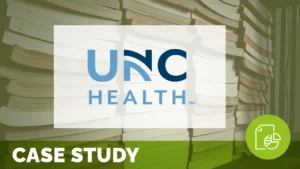A Committed Journey to Patient Experience Excellence: Environment, Process & Interactions

On the Road with Florida Hospital – November 2012
by Jason A. Wolf
Arriving in Orlando is a magical experience in itself. It is hard to escape the joy you see on the children’s faces who know they are about to see something magical and the sense of wonder on the faces of those departing about the experience and memories they will carry with them for a lifetime. Embedded in this mecca of magic and wonder, I had my own incredible experience in exploring Florida Hospital, a system of eight hospitals in Central Florida, and the strong intention they bring to ensuring that same sense of unparalleled experience for their patients, family and community. My On the Road visit exposed me to an environment that was grounded in solid and shared process and reinforced the importance of key interactions as central to positive outcomes. My host, Marcela Reyes, and her patient experience team exemplified one of the greatest and most comprehensive commitments to excellence in patient experience I have seen.
It Starts with a Foundation
I started my visit with a tour of the Florida Hospital Orlando facility. My guide was Ron Pasos, an architect for the system, who was excited to show me that while some of the facility was new, it was the foundations on which the organization was built, both literally and figuratively, that created the strength of the patient experience effort at Florida Hospital. While there was a newly constructed tower, the most important idea that Ron shared on the tour was not the incredible murals, mosaics or views, but rather how the facility reflected and reinforced the commitment of the organization to its mission – extending the healing ministry of Christ.
The subtleties, including the presence of employee photographs (FHotogaphy) and spaces for patients and families to rest and relax in what to many is a stressful and even fearful environment, were obvious. What was also apparent was the nature of the very people that I met on the tour. They smiled, were welcoming and as I watched them interact not only with me, but with the patients and families they were serving, it was clear they understood the values of the foundation on which organizations are grounded – the essence of culture and the people that enact and reinforce it in their actions. Before I even learned of the greater details of the Florida Hospital patient experience effort, I was seeing the process and ideas at work.
The story of the importance of building on a solid foundation is also now part of the hospital lore. Ron shared that in getting ready to pour the foundation for the new tower, the construction schedule for the work ended up having it planned for the Sabbath (recognized by the Seventh-day Adventists and the Adventist Health System of which Florida Hospital is a member). When the leadership and staff realized this, the team came together and requested the work be pushed back a day. This was of concern to the construction crew, both as it would most likely carry the work over into the start of the next work week and potentially disrupt things at the facility. The work was moved to sunset on Saturday evening, commencing with a service, and then the crew got to work. The feat that resulted was one Ron said is nearly impossible in most construction efforts. The pouring of the concrete foundation that should have taken days was completed almost overnight. The reminder this brought to the team at Florida Hospital was if you can be true to your mission – the foundation of what you do and how you do it – great things can be accomplished. This story reinforces the very notion at the heart of defining patient experience itself. It is based on and truly driven by the culture of an organization.
The Building Blocks of Experience – Three Stages of Experience and Sequential Steps for Execution
It is clear that Florida Hospital has made a commitment to the patient experience. They have put in place a significant infrastructure with which to design and implement their efforts. I had the opportunity to spend time with a number of members of the Patient Experience Team and in particular its leadership, Marcela, Kimberly Brown (Education/Operations Improvement Manager), Michelle Skunick (Senior Manager, Patient Satisfaction), and Julie Schaffer (Service Excellence & Patient Advocacy Manager). They provided me with an overview of an effort that not only framed their patient experience effort based on the voices of the patients themselves but also built in a clear and simple process that all staff could understand, engage in and effectively execute.
Three Stages of Experience Patient Experience Team
As the Patient Experience Team was being established at the system level, they conducted a study to understand patient perspectives across the continuum of care. The results of this effort not only informed the efforts of the team, they have also become part of the overall Florida Hospital Brand appearing on badges and signage across the facility. The stages identified were – Trust, Belonging and Hope. The words themselves are powerful in reflecting the needs of patients and families at each stage of their care. More importantly it helps the team at Florida Hospital remember the broad and systemic nature of the patient experience and that each of them, at every touch point, play a critical role.
Trust represents what people know and understand about the system and its hospitals and exemplifies the importance that experience starts well before someone enters a healthcare facility. It encompasses all the moments up to and beyond admission. Trust plays a critical role in engaging a patient, and is something that must be nurtured and reinforced throughout the care experience.
Belonging represents the feeling people want to have when they are in care. Patient want us to know them as people, with stories, emotions and needs, not as room numbers, diagnoses or charts. Creating a sense of belonging is important even for those patients who did not choose to be in a facility or who may be facing tenuous or fearful moments. Acknowledging the humanness of those in care provides a sense of individuality and recognition that ensures people feel cared for throughout their clinical experience.
Hope represents all that comes as a result of care from discharge and beyond. It is the hope of healing and the support of recovery. It also suggests that when people leave the care environment, the expectation is they feel supported and positive about their experience. The power of hope is strong and helping patients and families leave with this mindset not only supports outcomes, it also allows individuals to share the way their experience impacted them with others. When people leave with hope, they can begin the cycle for others where trust is formed and the positive cycle of experience reinforced.
To have a system understand the patient perspective during the stages of their encounter is significant and even elegant in its simplicity. It allows staff across the system to recognize their role and contribution to experience and maintains a broad and global perspective that the focus on experience truly never ends.
Sequential Steps for Execution
While understanding the stages of experience are important, the Florida Hospital Patient Experience Team recognized the need to create an infrastructure to support and guide the execution of efforts. The team has built a focused plan of clear replicable actions to ensure consistency of action across the system.
The process, dubbed sequential steps, has guided the patient experience team’s efforts. Grounded on a comprehensive data reporting effort (a process which could take up an article of its own), the Patient Experience provides a robust review of patient feedback and analysis of results, including extensive reviews of patient comments that provide a foundation on data from which to act. The team trains leaders across the organization how to access, review, interpret and ultimately act on the results. They have also built a consistent schedule of reporting from weekly updates to annual reports that in total help leaders to take the actions needed in impacting and improving patient experience.
When the Patient Experience Team first formed, they, like many teams I have encountered, worked to address the myriad of issues that came their way as they appeared. This led to solid, but scattered improvement. One of the many things that stood out about the Florida Hospital Patient Experience Team was their commitment to research, exploration and learning from others. As they saw their efforts diffused, they looked for a way to more effectively address the broader needs of the organization, which led to the identification of the steps.
While I have seen these concepts implemented in other organizations as separate “must have” tactics, the team at Florida Hospital stressed the importance of the sequential nature of the effort. The steps include:
- High, Middle and Low (Identification and actions around high, middle and low performers)
- Leader Rounding on Employees
- Leader Rounding on Patients
- Hourly Rounding
- Discharge Calls
The steps themselves probably do not require significant review, many of these concepts are understood and being used at facilities around the world. Their importance as the team conveyed was one, having a clear set of shared actions everyone is responsible for, and two, following a clear order in building on a patient experience plan. Many organizations try to tackle some or all of these tactics as initiatives in their organizations. What the team at Florida hospital has done is made these efforts gateways to the next step. It is only once a unit has mastered a specific step that they should consider moving on to the next. Rather than a laundry list of ideas, these have been framed as building blocks of a comprehensive experience process designed to impact the organization overall.
To support each step, training has been developed to prepare leaders on how to execute the specific step. From performance and coaching in high, middle, low to the intentionality it takes to execute on hourly rounding, each step has an infrastructure of support from learning, to reporting that supports and reinforces the importance of that step. As important is that teams are not pushed to simply check off each step, but rather master them so they take hold, have staying power and ultimately lasting impact on experience.
Of significance in the sequence is an idea that we discussed at the start of this story, the centrality of culture as a foundation on which experience efforts are built. The Patient Experience Team, based on their research exemplified this idea, as the first steps in the process are not about the delivery of experience to others, but first and foremost the development of the right cultural foundations of people and behaviors in the organization itself. These ideas conveyed through the organization’s compassion behaviors and image standards, are part of the organizations overall service expectations. They are conveyed in New Employee Experience classes, reinforced by leader rounding and measured in yearly reviews.
The importance of what I saw at Florida Hospital is that they have taken the some of the core ideas that have clouded the patient experience space and gave them structure, process and purpose. They have provided a framework for not simply implementation, but more so effective execution and sustained effort. Through data, training, standards and action they have built an engine refined to drive experience results. They too, as do many leaders on this journey, recognize that these efforts are not outcomes to be achieved, but ongoing efforts with no true finish line. The patient experience team prided itself on its ability to keep the process moving, expanding, and evolving. It was more than just listing core actions, it was the ability to identify, refine and disseminate the learning across the system so that everyone could continue to learn and improve.
The Support of Leadership
The phases of experience, sequential steps and critical importance of culture as a foundation to success was reinforced during my conversation with Sheryl Dodds, SVP and Chief Clinical Officer. As Executive Champion for the patient experience effort, the consistency and clarity with which she conveyed the patient experience effort exemplified the power of leadership support itself. I have always suggested based on both my research and ongoing observation that leadership support plays a critical role in patient experience success. The Institute’s Benchmarking Study identified leadership as the number one support in a successful effort. Leaders provide the support, reinforcement, even “air-cover” for patient experience efforts to grow and thrive. At Florida Hospital it was clear, as exemplified by Sheryl, that leadership was not just in support of an effort, but was actively engaged in its value to the organization.
Sheryl shared that the intention of the effort overall was to ensure the patient was clearly at the center of all that is done at Florida Hospital, adding that these were not just words, but the important thing was measurable action. She added that success was driven by ownership of these actions by individuals at all levels and that it needed to start with and be exemplified by the actions of leaders themselves. When asking why leadership was seemingly so supportive at Florida Hospital, Sheryl responded that healthcare is data driven and that the team has done an excellent job of not only capturing the data, but also helping people understand it in a way that it reinforces not only the importance for action, but also the impact of these actions on overall results.
In the end she offered that the most critical thing in addressing patient experience is to recognize it is a strategic imperative, one unquestionably intertwined with the very culture of the organization. “You have to recognize that patient experience is not something you do in addition to your other efforts, rather it is integral to who you are as an organization.” Through Sheryl’s efforts and the unwavering support of leadership at all levels it is clear that the patient experience effort at Florida hospital is not an initiative, but an integrated part of who they look to be as an organization. This may be no better exemplified than in the encounter I had with Patricia Price, AVP, Nursing, who shared how they were reinforcing accountability for experience at all levels in the organization.
An Infrastructure for Accountability
The structure for accountability at Florida Hospital is a case study in itself about the power of engaging leaders at all levels to enact and reinforce experience efforts. The practice shared by Patricia is “barrier meetings”. This practice has nurse managers report every week on their progress around key experience measures. They come prepared to share where they are succeeding, but more importantly to share where they are stuck, present the actions they are taking to address the issues they are facing and in the process share their experiences with their peer leaders in the room. In case you are wondering, I did say weekly reports with action plans and real consequences for inaction. While many organizations run from an infrastructure of review committees or meetings, Florida Hospital has embraced these as learning and support opportunities, which not only help highlight strengths and reinforce proven practices, but also enable quick adjustments and rapid improvements. Rather than feeling stuck trying to address a required action on their own, the Florida Hospital team has built an infrastructure for accountability that reinforces this is a community versus an individual effort.
It is clear the intention is to ensure all those taking action have the chance to learn from and support one another and ultimately see success in their actions. A comprehensive structure is in place that drives issues from the front line in Patient Experience Workshops to Senior Leadership Committees also addressing the issue of experience. Patricia said, “In taking the conversation on patient experience to the front line we have to help them understand the “what’s in it for me”, but perhaps more importantly we have to reinforce its importance to what we do as an organization. When I tell my nurses that an action such as hourly rounding is as equally as important as taking a blood pressure or delivering a medication, you can see it sink in. [Experience] is that important to who we are and what we want to be.”
Back to Foundations – Making Dreams Reality
Seeing the level of accountability for the overall plan at Florida Hospital brought my visit full circle and also reinforced the recognition that it was the people and culture of Florida Hospital that was truly the heart of their patient experience effort. From the foundations shared by Ron, to the profound simplicity and effectiveness of the infrastructure developed by the patient experience team, from the unwavering support of leadership, to the consistent reinforcement of front line accountability, Florida Hospital and the Patient Experience Team have supported a critical point about experience. It is not about a secret plan or complex initiative, but it is around doing what we know is right well, consistently, and with clear purpose. That purpose is alive and well at Florida Hospital and in my short visit I was left still wanting to see and hear more. The intention with which they address this issue is an example for many to follow.
At the end of my tour with Ron we stopped in the lobby of the Walt Disney Pavilion at Florida Hospital for Children. It was an incredible environment in which children could escape the fears accompanying their illness and remember first and foremost they are a child. In that wonderful environment was a small sign hidden just around the corner that while somewhat out of view, perhaps was the most important statement representing my visit to Florida Hospital. It was a quote from Walt Disney that read,
You can dream, create, design, and build the most wonderful place in the world,
but it requires people to make that dream a reality.
The lesson is poignant and important. It underscores the structure of the patient experience effort at Florida Hospital, it reinforces the importance of their priorities, and it highlights the very essence of culture at the core of the definition of patient experience. It requires people to make that dream a reality. What I saw at Florida Hospital was nothing short of an incredible family of people – caregivers, support staff and leaders – who were working to make that dream come true for so many each and every day.
Many thanks to the Florida Hospital Patient Experience Team and to all those who took time to say hello during my visit.
Related content
-
 Infrastructure & Governance | Policy & Measurement
Infrastructure & Governance | Policy & MeasurementA Global Perspective on Experience Excellence: Examples from Around the World
Join Vita Steina to learn more about her Fellow in Human Experience (FHX) project to explore and gather a collection of leading practices driving experience excellence globally. Vita’s project provided a comprehensive look at how organizations around the world are working to advance their experience work in a variety of critical ways. This collection of
Learn more -
 Environment & Hospitality | Staff & Provider Engagement
Environment & Hospitality | Staff & Provider EngagementPatient Experience Coaching in Ambulatory Care
Sharing is caring. Read how Marshfield Clinic Health System improved patient experience in its medical offices through observation and coaching of care teams. Learn how Patient Experience Coaches, a novel concept in ambulatory care settings, followed the patient journey through their clinics and identified improvement areas that focus on retention and recruitment of ambulatory care
Learn more -
 Environment & Hospitality
Environment & HospitalityDesigning a Safe and Comprehensive Gluten-Free Menu to Improve the Human Experience
Discover how patient feedback at UNC Hospitals led to a comprehensive overhaul of gluten-free food safety protocols. This initiative targeted cross-contamination by establishing dedicated preparation areas for gluten-free items and enhancing staff training on allergy management. Beyond improving safety and expanding menu options, this project fostered stronger cross-functional collaboration and demonstrated a deeper organizational commitment
Learn more
